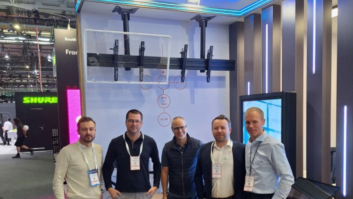The East European economies have spent the best part of two decades successfully transitioning from state-directed to privately owned markets.
Liberal laws for establishing new firms and a large pool of cheap and diligent labour have unleashed latent entrepreneurial talents and produced an aggressive private sector. The results are buoyant audiovisual markets which are among the most vibrant in Europe.
Economic and political stability, and for Poland, Hungary, the Czech Republic and seven other countries, membership of the European Union, has boosted investors’ confidence. Inevitably the global economic slowdown will take its toll, although growing intra-East European import/export should stabilise economies, albeit not at the levels predicted a year ago.
The communications infrastructure, which had stagnated for a decade, is being digitised at pace. Out-of-home advertising networks, cinemas, TV and radio stations are moving headlong into digital (HD) technology, creating installation opportunities.
“We’re seeing an increase in audiovisual installations especially in the digital signage market, which is widespread and growing rapidly throughout the region,” observes Christian Lutz, Gefen’s international sales manager.
Gefen recently installed 100 HD AV distribution solutions for a retail chain in Poland. “Until now, analogue technologies have been most prevalent in Eastern Europe, but we’re already starting to see digital penetrate these areas,” Lutz adds.
Full membership of the eurozone is next on the agenda. So far, Slovenia has adopted the single currency and Slovakia will do so next year. No other country in the region looks close.
“Once the CEE [Central and Eastern European] countries joined the EU they got access to structural funds to build their economy. This has been good for them and good for the AV business,” reports Tim Penn, AMX’s MD, marketing and sales, Europe.
This year AMX exchanged its distribution contract with Germany’s COMM-TEC to better capitalise on the East European market from a new company office in Stuttgart.
“The interest and demand in the region is way above our expectations,” Penn says. “We’re starting to find not only more distributors in Poland and Hungary but a lot more projects.”
Fellow control systems supplier Crestron has also seen growth rocket: “We had 40% growth in East Europe in 2007 and forecast the same this year,” reveals Serge Philippo, sales manager EE and Russia, referencing a management control system installed at the Polish State Opera by Wroclaw-based Microtech.
“We’re just seeing the tip of the iceberg. These are very fast-growing markets when you compare them with neighbouring countries. There’s a huge demand for new technology.”
Although interest is being generated in education, commercial and governmental projects for both companies in all three territories, it is the residential market that is showing most activity – and demonstrating surprising robustness.
“There’s a burgeoning wealthy elite who want control systems in their home or private yachts, and there’s a growing second tier of citizens who are exposed to new technology on foreign travel, have a high disposable income and are achieving a new standard of living,” says Penn.
“Bars and restaurants are continuing to install plasma screens, for example, to draw people in, but the solutions tend to be simple, lacking the sophisticated controls we are seeing in corporate or residential environments.”
However the region is still playing catch-up to its Western counterparts, admits Philippo. “We’re a step behind. The residential market is not as strongly affected by economic downturn, although it’s not growing as fast as six months ago. We’re seeing continuing sales of home theatre systems and demand among private users to control their home environment.”
At risk
Of all the East European countries, Hungary is most at risk from recession since it is most dependent on the continuing confidence of the capital markets and depends heavily on exports to Western Europe, which account for nearly 40% of GDP.
After an over-zealous spending and borrowing splurge in the early years of this decade the government was faced with a budget worth a yawning 9.4% of GDP in 2006. Unpopular austerity measures, including the heaviest tax burden in the region, were on track to reduce that to 3.5% by the end of 2008 until the recent crash forced Hungary into a multi-billion dollar IMF handout. There’s growing speculation that the 2010 election may be brought forward.
“The situation is very flat,” says Gabor Csapo of Hungarian AV supplier Rexfilm. “This has a direct influence on the B2B market.”
On hold
Plans for a 400million euro complex of five super-casinos in Bezenye on the north-west border with Austria and Slovakia remain on ice. The EuroVegas concept has been doing the rounds since the millennium with Australia’s Publishing & Broadcasting, its lead backer, hoping to attract wealthy Russians to what would be Europe’s largest casino, hotel and golf resort.
“The main companies with installation needs are the Hungarian branches of multinational firms, energy companies and the education sector in which the government has heavily invested,” says Attila Nagy, marketing manager for 10-year-old Budapest-headquartered Lightware Visual Engineering, a developer of matrix switchers, distribution amplifiers and accessories.
“HD signal distribution and HDMI connection are increasingly popular,” Nagy suggests. “HD broadcasts began this year on MTV1 and MTV2 [the state TV channels], which has helped spread this technology. In the staging market there’s big demand for panoramic projection, LED walls and 3D projection. We’d like to see more demand for simulator applications or where seamless side-by-side projections are needed.”
According to Csapo, however, the building of a new MTV facility, which began a year ago, may be cancelled because of the political and economic situation: “Of course MTV will need new systems, studios, audio consoles, but we don’t know when yet.”
Tamás Kelemen, Sony’s sales and marketing manager in Hungary, reports that customers are turning from DLP technology as their projection choice to 3LCD technology, attracted by a better picture quality.
“With the price of high ANSI lumen projectors continuing to fall, customers are able to afford more high-end models than before,” Kelemen says. “Museums and other cultural institutes are also fuelling this rise as using projectors has been proven to enrich the visitor experience.”
“The Hungarian market is more a follower than an innovator of technology,” adds Nagy. “We’re not involved yet in new technologies, such as digital signage. Interest in control room projector wall installations this year revived again, but I fear with the global slump it will decrease soon.”
Poland by contrast is considered the powerhouse of the region, with 38 million people and GDP growing at over 6% a year. The mass emigration of over 1 million young people to other EU countries means that unemployment, which stood at 20% in 2003, has dramatically decreased.
Indeed many Poles who left to work abroad are coming home, tempted by higher wages and a strengthening zloty against the euro. Demonstrating the growing importance of the market, internet search engine Google last year opened its first East European agency, in Warsaw.
Hosting the Euro 2012 Football Championship (with Ukraine) is a key driver for investment and one that will give a significant boost to the advertising market. One drawback is that it may contribute towards a bigger budget deficit, hindering Poland’s chances of entering the eurozone before 2013.
The country’s television market is widely acknowledged as one of the most dynamic in Central or Eastern Europe. It includes the region’s second-largest cable industry (after Russia) and no fewer than three direct-to-home platforms. Taken together, they already provide digital services to almost two-thirds of all TV homes. Almost one in five Polish TV households (17%) in large cities feature HD-ready TV sets, while in the country as a whole the figure is nearly one in 10 (8.9%).
“Overall business is flat but most of the major projects are in the TV area, especially OB vans,” reports Zdzislaw Rudzki from Lawo’s Polish distributor ZEP. “Unfortunately for Lawo the strongest position for large recording consoles is held by StageTec, while smaller projects are oriented towards multipurpose digital desks from Yamaha or Tascam.
ZEP has however just delivered an OB van for Warsaw’s public radio station, Radio Dla Ciebie, featuring a Lawo Zirkon XL console.
“The dual impact of HD broadcasts as well as plans to refurbish Poland’s football stadia and communications infrastructure ready for the Championship is having a significant impact on residential installations,” says Grzegorz Augustyn, proprietor of Polish custom installation firm Art Cinema. “New technology is being brought into the country for 2012 and the adoption of plasma and LCD panels for HD is building momentum behind investment in home entertainment systems.”
Augustyn’s company is his country’s sole representative of CEDIA, something that he feels differentiates the business from competitors.
“The Polish market is one of great opportunities,” he says. “But it is immature, by comparison with, say, Germany. We have lots to do. There is no standardisation or protocols for custom installations and there is limited education. When applied to Poland, CEDIA’s standards act as a filter for customers to recognise companies with a high level of service.”
Property tycoons, part of the new Polish elite, are among Augustyn’s key clientele and they bring a mix of residential and commercial projects to the table.
“Those two markets are fused together. Hotels, corporations, museums – most of this investment comes from private not government money. As such the budgets are higher and they demand higher standards.”
Consistent performer
Arguably the most stable of the post-communist states, the Czech Republic has enjoyed growth over 6% annually in the past three years. Most of the economy has been privatised, including banks and telecommunications. Indeed the prosperity of its 10 million inhabitants is envied by fellow East European states.
Next January the Czechs take over the rotating presidency of the EU, chairing all meetings and setting the agenda for the following six months. Two-thirds of Czechs told a recent Eurobarometer poll that their country had benefited from membership, above the EU average. However, this sits at odds with the eurosceptic views of the country’s leadership, which virtually scuppered the Lisbon Treaty (along with Ireland) earlier this year.
“The installation market is stable, even rising slightly,” reports Lawo’s country representative Philipp Hey. “LED applications, digital signage, IPTV/streaming and digitising in general are very active sectors and the prognosis is good.”
Key projects are digital TV station Z1 TV, which launched in June, and investments in Rudolfinum, the home of the Czech Philharmonic Orchestra; the Estates Theatre (Prague); Czech Radio (Plzen) and a World War II memorial (Hrabyne).
“There are many theatres, museums, private radios, clubs and sports arenas with older technology that should be renewed in the near future,” says Hey. “We are also expecting new multifunction arenas (one is earmarked for Kladno) and theme parks.”
According to David Lesch, co-founder of Czech distributor and integrator AV Media, the market has matured. “There’s no doubt that integration is becoming increasingly important. The price of equipment is going down, which is why customers are ready to invest in more equipment for each project, and that means the demand for integration skills is also increasing.”
Interactive whiteboards, telepresence, control systems involving room reservation and remote control, 3D projection, and new format projectors (16:10 and WXGA) all provide new opportunities for integrators, he adds. “It’s really a very exciting time to be in this business.”
Opportunities in entertainment venues, theatres, museums and the residential market will provide growth potential. “We would like to play a stronger role in the central European region, and to this end we established a joint venture with Hungary’s Brill Audiovisual Systems.”
One of the few global manufacturing names to emerge from the country is lighting specialist Robe, although the majority of its business is exports.
“Digital and LED lighting is on the rise,” says MD Josef Valchar. “With LEDs, people are realising the long-term benefits of reducing their running costs and carbon emissions. With digital lighting, people are looking at the massive flexibility offered by the fusion of lighting and video technologies.”
Robe has just launched a range of products that combine digital and LED technology. These were highlighted at Robe’s roadshow, which recently toured Poland, Hungary and Russia: “We’ll be going back to all three countries as the interest was so intense,” adds Valchar.
The entire region is about to get a major shake-up in digital cinema which could see Poland leapfrog every European country bar Norway.
“Until six months ago cinema infrastructure in Eastern Europe languished far behind the West,” explains Screen Digest’s cinema expert David Hancock. “The UK houses 70% of screens in multiplexes. By contrast, multiplexes account for 45% of screens in Hungary and Poland, and just 20% in the Czech Republic.”
Concerns that independent theatres – often the only cinema available in small towns – may be forced out of business without digital upgrades has prompted the Polish government to act.
Described by Hancock as “innovative” and “the first major public initiative” from the region, the government is to fund conversion of 400 small screens, or half the country’s total, with members of KIPA, the Polish Audiovisual Producers association, contributing a portion. The aim is to maintain Poland’s own-language film production, but it will also be a boon to local AV integrators.
“Digital itself is not a driver for cinema admissions,” says Hancock. “What is needed is wholesale refurbishment of the cinema environments themselves. There’s no point putting digital technology into sub-standard theatres.”
Additionally, Cinema City International, an Israel-based distributor and the largest multiplex operator in Eastern Europe, is to equip 50 of its 500 screens (mainly in Poland, Hungary and the Czech Republic) with 3D systems, effectively digitising screens in the process. Poland currently has 25 digital screens, Hungary has five, and the Czech Republic none, compared with over 1,000 in Western Europe. That figure is set to catapult upwards.
As is the case across Europe, and indeed the world, the coming months and years look set to bring increasing uncertainty. It remains to be seen how these developing markets will fare.







